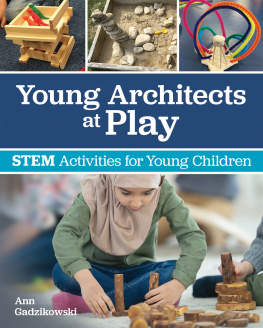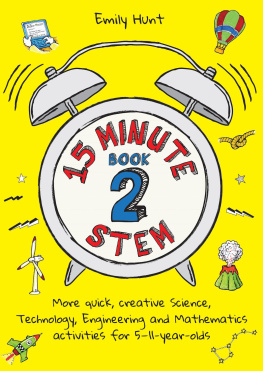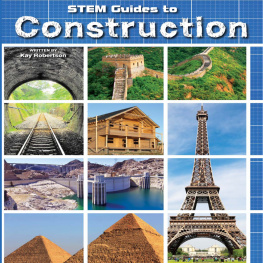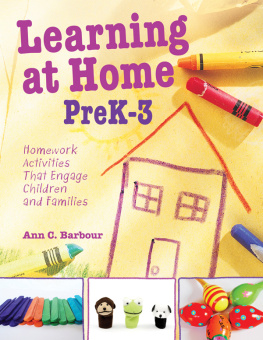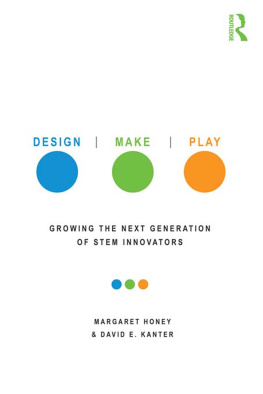
Young Architects at Play
STEM Activities for Young Children
Ann Gadzikowski

Published by Redleaf Press
10 Yorkton Court
St. Paul, MN 55117
www.redleafpress.org
2021 by Ann Gadzikowski
All rights reserved. Unless otherwise noted on a specific page, no portion of this publication may be reproduced or transmitted in any form or by any means, electronic or mechanical, including photocopying, recording, or capturing on any information storage and retrieval system, without permission in writing from the publisher, except by a reviewer, who may quote brief passages in a critical article or review to be printed in a magazine or newspaper, or electronically transmitted on radio, television, or the internet.
First edition 2020
Senior editor: Melissa York
Managing editor: Douglas Schmitz
Art director: Renee Hammes
Cover design: Michelle Lee Lagerroos
Cover photograph (bottom): iStock.com/FatCamera
Interior design: Percolator
Typeset in Abril Text
Printed in the United States of America
The book covers on are reproduced with the permission of the publisher, Penguin Random House, New York, NY.
Library of Congress Cataloging-in-Publication Data
Names: Gadzikowski, Ann, author.
Title: Young architects at play : STEM activities for young children / by Ann Gadzikowski.
Description: First edition. | St. Paul, MN : Redleaf Press, 2021. | Includes bibliographical references. |
Summary: When we see childrens construction play through the lens of architecture, we are able to support and extend childrens learning on all four STEM subjects: science, technology, engineering, and math. Young Architects at Play is a guide for both teachers and parents and includes a diverse variety of activities and resourcesProvided by publisher.
Identifiers: LCCN 2020010357 (print) | LCCN 2020010358 (ebook) | ISBN 9781605547008 (paperback) | ISBN 9781605547015 (ebook)
Subjects: LCSH: Early childhood educationActivity programs. | ScienceStudy and teaching (Early childhood) | Play.
Classification: LCC LB1139.35.A37 G34 2021 (print) | LCC LB1139.35.A37 (ebook) | DDC 372.21dc23
LC record available at https://lccn.loc.gov/2020010357
LC ebook record available at https://lccn.loc.gov/2020010358
To the many talented and caring teachers and staff members at Preschool of the Arts in Madison, Wisconsin
Contents
Acknowledgments
The winter conference of the North American Reggio Emilia Alliance took place in Madison, Wisconsin in March 2019. My job as a conference volunteer and chair of the local Wonder of Learning exhibit was to drive the featured speakers from place to place. These honored visitors included Marina Castagnetti, an Italian author and educator who worked with Loris Malaguzzi in creating the acclaimed preschools and infant-toddler centers of Reggio Emilia; Nunzia Franzese, a rising pedagogista in Reggio Emilia; and Jane McCall, their expert interpreter.
On their one free afternoon in Madison, I asked where I might take them. They said they wanted to see the work of the Wisconsin-born architect Frank Lloyd Wright. So we spent a lovely afternoon visiting landmark Wright buildings, including the First Unitarian Society Meeting House, with its striking geometric windows and vaulted roof.
As we visited these beautiful buildings and talked about our work with children, I was impressed by the many similarities between designing a building and educating a childtwo important endeavors that require an understanding of both art and science. The experience deepened my interest in exploring the synchronicities between architecture and early childhood education. Im grateful to Marina, Nunzia, and Jane for sharing that reflective afternoon with me.
Im also grateful to the children, families, teachers, and staff members of Preschool of the Arts in Madison for deepening my knowledge and experience of Reggio-inspired practices. In particular, this books emphasis on the use of provocations in inspiring childrens curiosity is largely informed by my experience at Preschool of the Arts.
I also thank the children, families, teachers, and staff members at School for Little Children in Evanston, Illinois. Many of the activities in this book were developed and tested in the science, technology, engineering, and math (STEM) enrichment classes I teach there with three- and four-year-olds.
Ive always enjoyed block playfirst as a child and later as a teacher. My work at Northwestern Universitys Center for Talent Development (CTD) sparked an even deeper interest in the field of architecture and its relevance to early childhood curriculum. Im grateful to my CTD colleagues Susan Corwith, Beth Dirkes, and Leslie Morrison for their support, encouragement, and collaboration in developing and piloting architecture courses for young children, such as Blocks and Blueprints and LEGO Metropolis.
Many thanks to the wonderful people at Redleaf Press, who continue to champion my work and my books. Its such an honor to be able to call myself a Redleaf author. Im grateful to Meredith Burks, Heidi Hogg, and Melissa York for their roles in creating this book. Im especially thankful for the opportunity to work with the amazing Angela Wiechmann on the editing process.
As always, Im grateful for the love and encouragement of my friends and family. Thank you for helping me lug my bags and boxes of blocks from place to place, and thank you for listening to my dreams.
Prlogo / Foreword
Jorge Raed, director, Osa Menor Arts Education for Children and Youth
Bogot, 20 de febrero de 2020
El libro de Ann es agradable, sencillo y til. Est escrito con sus aos de experiencia como profesora de jardn de infancia, tras muchas horas de observacin, experimentacin y estudio de la realidad infantil.
Ann ha probado diversos materiales y procesos inspirados en la arquitectura y el diseo: volmenes geomtricos, palos, bloques y todo aquello que nos permite levantar estructuras, construir ambientes, esbozar mundos urbanos con calles, casas, parques maquetas y escenografas que permiten al nio tejer narraciones simblicas donde puede construir sus deseos, voluntades, temores juegos simblicos para tejer la red social donde el nio, desde que nace, es.
Cuando digo que hay proyectos que abordan la infancia, la arquitectura y la educacin hablo de una extensa gama de profesionales que trabajan desde diferentes enfoques con diversos objetivos.
El mapa de los proyectos que anan infancia, arquitectura y educacin podra ser as:
Aprendizaje de la arquitectura como un lenguaje del arte. Igual que los nios aprenden msica, pintura, teatro aprenden arquitectura. Cursos y talleres que introducen a los pequeos el ABC de la disciplina: estructura, escala, proporcin, materiales, luz y sombra, colores, programa, contexto histrico y urbano, sostenibilidad
Procesos de diseo participativo con protagonistas infantiles en la transformacin de su mundo. Cmo? Con proyectos donde los nios, con ayuda de sus maestros, profesionales del diseo, padres y comunidad estudian un problema y lo solucionan con el diseo y construccin. Por ejemplo, la transformacin del patio escolar.
Procesos de regeneracin urbana: aquellos proyectos que quieren mejorar el espacio urbano donde vive la infancia. Por ejemplo, mejora de parques, patios de recreo, y barrios en mal estado fsico y social, y reformas de edificios puntuales como colegios o bibliotecas que ayudan a transformar un sector de la ciudad.
Next page
